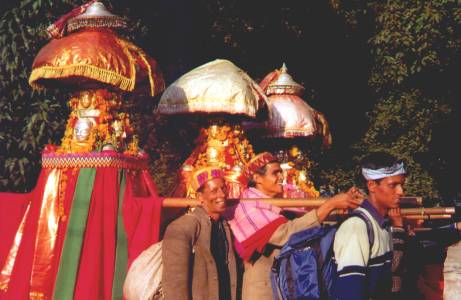
The Dussehra Festival in the Kullu Valley is over now,
and the local gods begin their journey homeward.
Bill and Bessie Too tell their tales of the Himalaya: Part Four—Rampur to
Mandi
Mandi, Himachal Pradesh, India
3 November 2002
Cycling along the lower Sutlej Valley past subtropical vegetation with its flowers and sweet smells was an enjoyable contrast to touring in the high valleys of the last two months. Yet one more mountain region still called—the Kullu Valley. My maps showed a road that crossed over via the Jalori Pass (3228 m; 10,600 ft), and I decided to give it a try. The route followed the now wide and lazy Sutlej River for a while, then began to switchback up the hillside and curve around above a canyon of a tributary stream. By now I was well used to cycling along the edges of precipices hundreds of meters above the valley floor. (Anyone with a fear of heights would be killed or cured by cycling in the Himalaya!)
Luckily the little town of Ani had a place to stay, the optimistically named Skybar Resort, a very basic place but more convenient than camping. A local eatery served a simple dinner, the usual vegetables, rice, and dal. Next morning the climbing got serious—an unrelenting ascent up a wooded valley and a hillside, until finally reaching the pass in mid-afternoon. The weather was sunny, as usual, and I enjoyed vistas to the south of ridge after ridge interspersed with hazy valleys. To the north stood grand snow peaks soaring above forested ridges. The descent was awfully steep—brake failure was not an option. I stopped often to let the rims cool and to admire the dense forest. Some of the biggest and tallest trees I'd ever seen in India grow here—conifers and oaks mostly. Indians knew about the area, even if Lonely Planet didn't, and many villages had guesthouses. I stopped at one that had a group of friendly bachelors from Calcutta. The Bengalis love the Himalaya, and the Dussehra festival is their main holiday period.
Bessie Too and I had earned our LONG downhill the next morning through Tirthan Valley to the Beas River in the Kullu Valley. When I turned right on the highway upriver toward the town of Kullu, traffic was heavier than previously seen on this trip, but the riding was easy on the wide road. I stopped at Bajaura to see the shikara-style Basheshar Mahadev Temple, dedicated to Shiva. It's the largest stone temple in the valley and dates to the 8th-9th C. A Shiva lingam, covered with flower petals, stood in the inner sanctum, and three faces of Shiva looked out on all four sides of the exterior—the richly ornamented structure revealed great beauty. Kullu, the main administration town of the area, has no tourist attractions but was a handy place to stay. I enjoyed some South Indian food—a masala dosa and idlis—a rare treat in the Himalaya.
I took the back road to the village of Naggar (1760 m; 5800 ft), capital of the region for nearly 1500 years. Naggar has several old stone temples, picturesque stone-and-wood houses, and a lovely setting high on the east side of the valley. The 500-year-old castle had been converted to a hotel, and I had a couple of meals there while taking in the views over the Kullu Valley. I greatly enjoyed a visit to the Roerich Gallery, which was hosting a special exhibit of the Russian painter's depictions of the Himalaya. Nikolai Roerich (1874-1947) is renowned as a mystic and explorer as well as an artist—you can read more about him on the Internet or in a library. Through slightly abstract use of color and form, each of his studies and paintings shows the mountains in a different mood. Roerich's house, nearby in a secluded forest above the village, had been his "Shangri La" during his last years and is now a museum.
Nearly every cyclist riding to or from Ladakh begins or ends the trip at Manali (2050 m; 6800 ft) in the upper Kullu Valley via the Rohtang Pass (3980 m; 13,100 ft). Bessie Too and I had taken the much longer and tougher—but more interesting—route via Spiti, Kinnaur, and Kullu. I was still curious to see the pass, though, and signed up for a bus tour. I wasn't the only tourist—crowds of Indians were also going up in buses or cars. The bus followed the twisting road beneath sheer cliffs, passing waterfalls, forests, and alpine meadows. I walked across the pass to an overlook of the Lahaul Valley and spotted my route of several weeks ago. A cold wind blew from the south, and patches of snow lay about, as I enjoyed the panorama of the Himalayan peaks.
Manali isn't much to look at—just concrete boxes of hotels, restaurants, and shops—but the Indians love it. Many come for honeymoons or just for a cool holiday. Hand-woven shawls are the main product of the region, and shop after shop specializes in them. I bought some books and a flat-topped wool cap. (Many men of the lower Himalaya wear caps, and they are required for entry in some Hindu temples.) One of the books was Jim Corbett's Man Eating Leopard of Rudraprayag about his hunt in the 1920s for this terrible beast; the book is a real page-turner.
I enjoyed Manali's creature comforts for a couple of days, then it was time to move on. I cycled down the valley to Bhuntar, an unremarkable town with the valley's airport, but a handy base for the ride up the Parvati Valley to the pilgrimage town of Manikaran. On a day ride up and back, I followed the deep valley past villages and terraced fields, then entered pine forests farther upriver. If I'd kept going and negotiated the difficult 5319-m Pin Parvati Pass, I would have reached Mudh in the Pin Valley of Spiti, where I'd cycled earlier. Hot springs at Manikaran attract Sikh and Hindu pilgrims, as well as tourists. Religious souvenir shops line the narrow main lane. A Hindu sadhu offered me a smoke on his chillum (pipe), to which I declined with a warning that smoking was dangerous. The Hindu religion tends to be freeform and individualistic, so if a man wishes to abandon wife, kids, and other responsibilities to don a robe and smoke ganga in the hills, he can.
The ride from Bhuntar to Mandi down the Beas River took in both the ugly and the beautiful. Hydroelectric projects have scarred many valleys in Himachal Pradesh, and I had to ride past the clutter of concrete and power lines in clouds of dust in a few places. Beyond the destruction, I saw a high waterfall coming down the opposite side of the canyon amidst palm trees and lush greenery—a scene more out of a tropical paradise than here in the Himalaya.
Tire Blues
The German company "Continental AG" once made excellent
bicycle tires. I'd used them with success on my ride from Tibet to Pakistan three
years ago. But this time the tires and tubes were made in Asia and featured abysmal
quality at high prices. The first tire went out when its sidewall was slashed by
a stone after just two weeks of riding. The other tire suffered sidewall failure
from fatigue later in the trip. Then the Continental tubes started to go—tiny
cracks formed and began sprouting precious air after leaving the Sutlej Valley.
I was able to replace the tires with Indian ones (at one tenth the price), but Indian
tubes came only with an archaic valve that wouldn't fit my rims or pump. By the
time we'd reached Mandi, all my patches were used up!
My previous cycle trip had obvious ending points—the Pakistan-Chinese border in the north and the seas beyond Kanyakumari of India's extreme south, but where to end the present trip? Mandi seemed a good place. It was at a low elevation of just 750 meters/2500 feet, and there was little of interest farther south that I hadn't seen previously. Also, Mandi was on my cycle route three years ago of the lower Himalaya between Nepal and Pakistan—now Bessie Too and I had effectively cycled the entire length of India! Quite a series of rides!
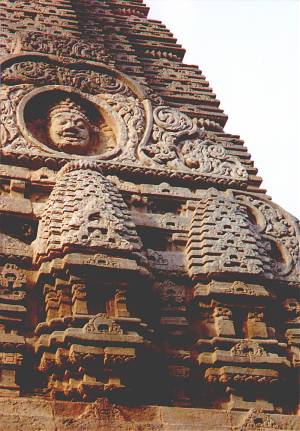 Basheshar
Mahadev Temple in Bajaura.
Basheshar
Mahadev Temple in Bajaura.

The Dussehra Festival in the Kullu Valley is over now,
and the local gods
begin their journey homeward.
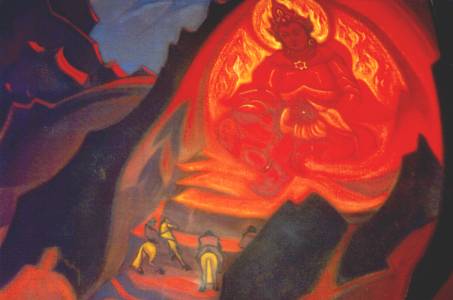
Himalayan Deity by Nicholas Roerich; at an exhibition in Naggar.
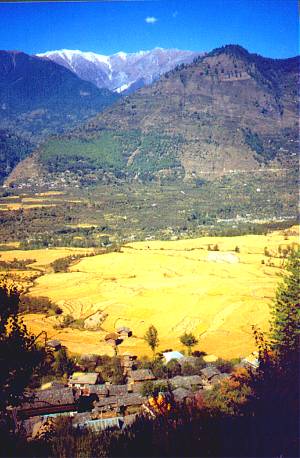 View
across the Kullu Valley near Naggar
View
across the Kullu Valley near Naggar
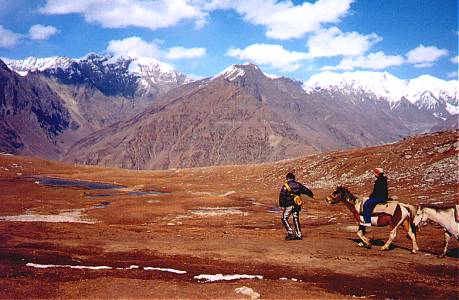
Indian tourists experience the thrill of horseback riding on Rohtang Pass (3980
m).
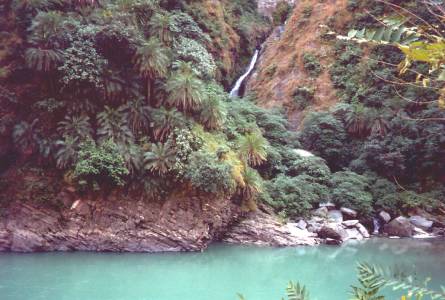
Palms surround a waterfall beside the Sutlej River.
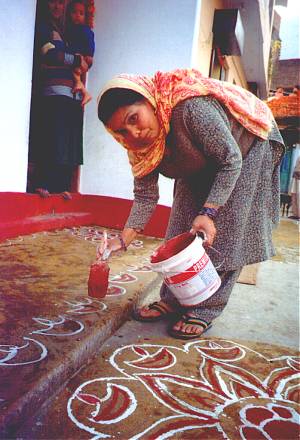 Decorating
for the Diwali Festival in Mandi
Decorating
for the Diwali Festival in Mandi
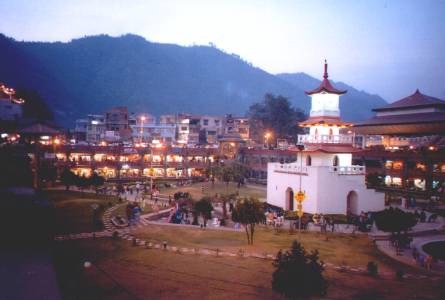 Indira
Market, Mandi
Indira
Market, Mandi